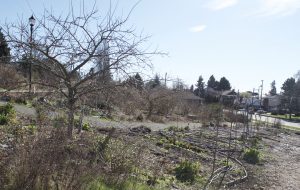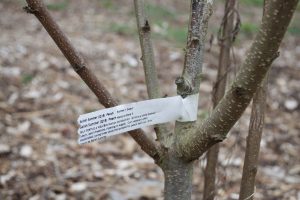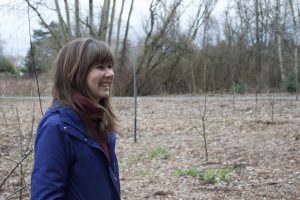Imagine that you’re in your kitchen, preparing to make spaghetti sauce. You’ve assembled the requisite vegetables on the counter and are now reaching into your spice cupboard for thyme and oregano. That’s when you realize you’re out of both spices. Instead of driving to the store to grab the missing ingredients, you take an empty bag from a hook near the door and walk three blocks to a park near your home. As you approach the park, you notice people standing near the trees and bushes, plucking fruits and snipping herbs. You join the scavenging party and gather a handful each of thyme and oregano, plus a rosemary sprig for good measure. After dropping the fragrant herbs into your bag, you head for home, but not before noticing the sign next to the exit: “Thanks for visiting our food forest.”
The term “food forest” may conjure up Candyland-like images of a place where pine cones have been replaced with bagels and chocolate bars nest inside sword ferns. In reality, food forests may not look that different from a backyard garden. In fact, food forests have much in common with community gardens, where city dwellers cultivate food in public spaces. People use food forests and community gardens to grow food for themselves or for others, and food forests and community gardens are frequently located in park-like public urban spaces.

Rosemary and oregano at the Beacon Food Forest (Heubach, 2018)
While community gardens and food forests share much in common, they have distinct design principles. Mia Boyle, a board member and volunteer group coordinator at the Beacon Food Forest, suggests that food forests are wilder than community gardens. She believes that with food forests, “what we’re doing is being a little bit more playful…you could look at it as being more haphazard and allowing things to be a little bit less organized.” Lizzy Stone, a program coordinator with a different local food forest, adds that plants in community gardens tend to be annuals, while perennials dominate in food forests. Stone also suggests that food forest design is even more rooted in nature: “In my understanding, a food forest is basically an orchard that tries to replicate natural systems [but] in contrast to an orchard, a food forest has different many layers, similar to an actual forest. So we have trees and we have shrubs and ground covers and vines and many different parts of an ecosystem, hopefully that all provide food in some way or contribute to this ecosystem, so it’s sort of like a permaculture* perspective on an orchard.”
|
What is permaculture? Permaculture is a holistic, sustainable approach to growing food. Permaculture gardens are inspired by wild ecosystems and work with garden areas’ natural design (Ferguson & Lovell, 2015; Hoffman, Doody, Veldey, & Downs, 2016). |
Another difference exists between food forests and community gardens. Community garden produce is typically meant for the people who grew and tended to it (Nordahl, 2009). In contrast, produce in food forests can be picked and consumed by anyone passing through them. Visitors who have played no role in maintaining the food forests are actually encouraged to harvest from them. Food forests are for foraging.
While relatively unknown outside permaculture circles, food forests, also known as edible parks, have been established throughout the U.S. You can find them in the Northeast, in cities like Boston and Albany, and in the Midwest, in places such as La Crosse, Wisconsin and Davenport, Iowa. In North Carolina, you could stop for plums and hazelnuts at the Dr. George Washington Carver Edible Park, possibly the first ever food forest. But you don’t have to travel out of state to experience a food forest: Seattle has three.
If you overhear Seattleites discussing a recent visit to a food forest, they’re probably talking about the Beacon Food Forest. The Beacon Food Forest is in north Beacon Hill, on the west side of Jefferson Park, a short walk from the VA hospital. Planning for the food forest began in 2009, and its 1.75 acres now contain a nut grove, berry patch, and medicinal herb garden (“Beacon Food Forest”). The food forest hosts frequent work parties, where volunteers gather to maintain the garden and share lunch. The Beacon Food Forest also hosts events, such as fruit tree pruning classes and plant walks with local herbalists.

Beacon Food Forest, facing south (Heubach, 2018)
Two miles south of the Beacon Food Forest sits a younger site: the Georgetown Urban Farm and Forest, or GUFF. The GUFF is located in the southwest corner of South Seattle College’s Georgetown campus. While smaller than the Beacon Food Forest, the GUFF still boasts a wide range of foods. You can find raspberries, growing from plants donated by the Beacon Food Forest, as well as raised beds of vegetables and a healing and cooking garden. The garden contains an amalgam of medicinal plants. Among them are lemon balm, known for its calming effects; agrimony, used to stop bleeding; and angelica, whose seeds and roots can help regulate menstrual cycles and alleviate cramps. Edible plants such as rosemary, lavender, sage, and bay are interspersed throughout.

Healing and cooking garden at Georgetown Urban Farm and Forest (Heubach, 2018)
Even though the GUFF and the Beacon Food Forest share some plants in common, these food forests occupy very different sites. The GUFF’s setting is much less pastoral, for it sits directly across from heavy industry. According to Mateo Espinosa, one of the GUFF’s co-managers, the GUFF was once part of the Duwamish River but later became a landfill. When preparing for planting, GUFF volunteers became acutely aware of this. While struggling to dig down into the compacted soil, volunteers unearthed waste such as bricks and bottles from the former landfill. Site managers have since instituted an intensive soil building regimen to improve the GUFF’s soil quality.
Seattle’s third food forest also occupies a highly manipulated site. It sits near the shore of Lake Washington in southern Seattle on land that was once lake bottom. When the Lake Washington Shipping Canal was built, it dropped the depth of the lake and exposed the land that the food forest currently occupies.
Seattle’s newest food forest is part of the Rainier Beach Urban Farm and Wetlands (RBUFW), which is Seattle’s largest urban farm. While the RBUFW is well-established, its food forest is not. The plants are all young fruit trees just starting to produce fruit. The forest’s lower shrub layer has yet to be planted but will eventually provide additional food for community members as well as habitat for beneficial insects. Even though it’s too early to harvest much from the sapling trees, all are welcome to explore the burgeoning food forest.

Rainier Beach Urban Farm and Wetlands, Seattle’s largest urban farm (Heubach, 2018)
While Seattle’s food forests differ in their stages of development, they share one key thing: a mission to support community. Food forests use their garden-like settings to bring people together and strengthen community ties. Creating community is not incidental to food forests—it’s fundamental. The Beacon Food Forest’s website states that its goals are to “bring the richly diverse community together” and “design, plant and grow an edible urban forest garden that inspires our community to gather together, grow our own food and rehabilitate our local ecosystem” (“Beacon Food Forest”). Community also figures strongly in the missions of the GUFF and the RBUFW, as well as the mission statements of food forests throughout the U.S.
When I spoke with volunteers and staff at Seattle’s three food forests, they confirmed that community is central to food forests. Stone affirmed the importance of community to RBUFW’s food forest: “We want the whole site and specifically the food forest…to be something that people from this neighborhood feel like they have a lot of ownership over…I think that’s one of the main goals of this site, to be bringing people together around food.” Bringing people together is also key for the Beacon Food Forest. According to Boyle, “Community building is one of our primary missions because without community there is no food forest, there is no need for it…there’s nothing…we want diversity, we want inclusion, we want all kinds of people feeling authorized to come and to be a part of steering the ship and where it’s going and just to experience it and experience one another. It’s so important…it’s really the major mission of a food forest, building community.”
Community members were intimately involved in creating Seattle’s food forests, especially the GUFF. According to Espinosa, the inspiration for the GUFF came out of a community survey process led by the Duwamish River Cleanup Coalition. There was a series of community neighborhood meetings where residents advocated for more green spaces, especially ones related to food, because Georgetown is a food desert. Residents ultimately voted to establish the GUFF. Veronica Andrade, another GUFF co-manager, confirms how community-centered the process was: “It [the GUFF] is a neighborhood project…from the root it’s linked to the community.”

Rhubarb at the GUFF (Heubach, 2018)
Seattle’s food forests also connect to their communities by addressing food security. In addition to promoting foraging, the food forests set aside some of their produce for sale at significant discounts. For instance, once the fledgling food forest in the Rainier Beach Urban Farm and Wetlands has matured, some of the fruit tree produce will be used in the Good Food Bags program. Tilth Alliance, a non-profit that co-operates the RBUFW, sponsors this program, which provides affordable locally grown organic produce to Seattle and south King County residents “with limited financial resources or inadequate access to fresh food” (“Tilth Alliance”). The GUFF has taken their mandate to provide the community with affordable fresh foods a step further by offering its produce free-of-charge at a local market. While the GUFF doesn’t package or sell any of its food—it’s all free for the taking—last year the GUFF contributed its surplus produce to Georgetown’s Carleton Grocery. Andrade confirmed that customers would take greens and carrots from the store for free. The Carleton Grocery—which was Seattle’s oldest grocery store (King, 2017)—has since closed though, cementing Georgetown’s status as a food desert and affirming the vital need for the GUFF.
Another way Seattle’s food forests intentionally support their communities is by providing on-site community gathering spaces. At the Beacon Food Forest, neighbors can congregate on wooden benches under the large semi-covered Gathering Plaza, where volunteers enjoy communal lunches during Saturday work parties. South of the Beacon Food Forest, community members can sit in the middle of the GUFF on colorful Adirondack chairs built by Duwamish Valley Youth Corps members. And further south, at the RBUFW’s food forest, residents will be able to come together in areas that have deliberately been left open. Stone describes how community engagement was built into the forest’s design: “As a part of the planning process, a lot of the folks who were part of those [design] charrettes talked about the desire to have gathering spaces, places to be in and experience the food forest as opposed to just having food for production, so that is a way we hope that the community will be able to engage with it in the future.”

Peach tree at Rainier Beach Urban Farm and Wetlands’ food forest (Heubach, 2018)
In addition to supporting already existing communities, the food forests also build community. Boyle believes that the Beacon Food Forest creates community through its group work parties: “There’s something very magical that happens with groups…you’re so surprised with how things get done and how it’s so much easier than you thought it was…that’s really the basis of what community is, it’s a kind of miracle that happens when communities come together.” Stone has also experienced community building at her food forest’s tree planting work parties, and she cites the food forest design process as another example of community building: “Throughout that design process, because we were including different staff and also program assistants and Friends of the Rainier Beach Urban Farm, we all did get together and share ideas and get to work on building it together, and so I definitely feel a lot closer to those people, being a part of that group, and I felt like that process helped us all buy into it a lot more.” Stone also expects the food forest to continue catalyzing community growth: “I hope that in the future, like for example as we have these pruning workshops…where people are coming together and sharing their own knowledge and helping to shape the place to be the way they want it to be…that will help us build a lot of community around it [the food forest].”

Lizzy Stone, Community Education Program Coordinator at Rainier Beach Urban Farm and Wetlands (Heubach, 2018)
Espinosa and GUFF co-managers Andrade and Angielina Chamberlain argue that food forests are more than spaces for building community and providing food—they’re radical experiments. Espinosa says, “I think this is a very political, revolutionary endeavor…making food for free…creating a place where some of those rules don’t really apply here, really building stuff from [an] industrial wasteland, stuff that grows on its own—I think we need more of that.”
“It is a political move,” suggests Chamberlain.
“A quiet one though,” adds Andrade.
—
If you agree and want to support Seattle’s food forests, you can donate your time at one of their work parties:
- Beacon Food Forest
- Work parties the third Saturday of every month, from 10 – 2
- 15th Ave S and S Dakota St
- Find upcoming work party dates at http://beaconfoodforest.org
- Georgetown Urban Farm and Forest
- Work parties every other Saturday, from approximately 10 – 2
- 6737 Corson Ave S
- Send a message to the GUFF’s Facebook group to confirm work party dates: https://www.facebook.com/georgetownurbanfarm/
- Rainier Beach Urban Farm and Wetlands
- Work parties on Saturdays, once a month, from 10 – 2
- 5513 S Cloverdale St
- Check Tilth Alliance’s website for upcoming dates: http://www.seattletilth.org/get-involved/volunteer/farm-garden/rbufw-volunteer
Gardening skills are not a prerequisite for any of these gatherings. Novices and green thumbs alike are welcome. Just don’t forget to bring your foraging bag with you.

Angielina Chamberlain, co-manager of Georgetown Urban Farm and Forest (Heubach, 2018)
—
References
Beacon Food Forest. (n.d.) Retrieved Feb. 6, 2018 from http://beaconfoodforest.org/
Ferguson, R. S., & Lovell, S. T. (2015). Grassroots engagement with transition to sustainability: Diversity and modes of participation in the international permaculture movement. Ecology & Society, 20(4), 601-619.
Georgetown Urban Farm and Forest. (n.d.) Retrieved Feb. 7, 2018 from http://www.georgetownurbanfarm.com/mission.html
Hoffman, A., Doody, S., Veldey, S., & Downs, R. (2016). Permaculture, fruit trees, and the ‘Motor City’: Facilitating eco-identity and community development in Detroit, Michigan. National Civic Review, 105(2), 3-7.
King, M. (2017, December 26). Seattle’s oldest grocery store, open since 1911. King5 News. Retrieved from http://www.king5.com/article/entertainment/television/programs/evening/seattles-oldest-grocery-store-open-since-1911/281-140156267
L. Stone, personal communication, March 2, 2018.
M. Boyle, personal communication, February 28, 2018.
M. Espinosa, V. Andrade, & A. Chamberlain, personal communication, March 3, 2018.
Nordahl, D. (2009). Public produce: The new urban agriculture. Washington, D.C.: Island Press.
Tilth Alliance, n.d. Good food bags. Retrieved from http://www.seattletilth.org/about/good-food-bags
CATEGORIES: urban agriculture, food forests, edible parks, community, food insecurity
SaveSave
SaveSave
SaveSave
SaveSave
SaveSave
SaveSave
SaveSave
SaveSave

Leave a Reply